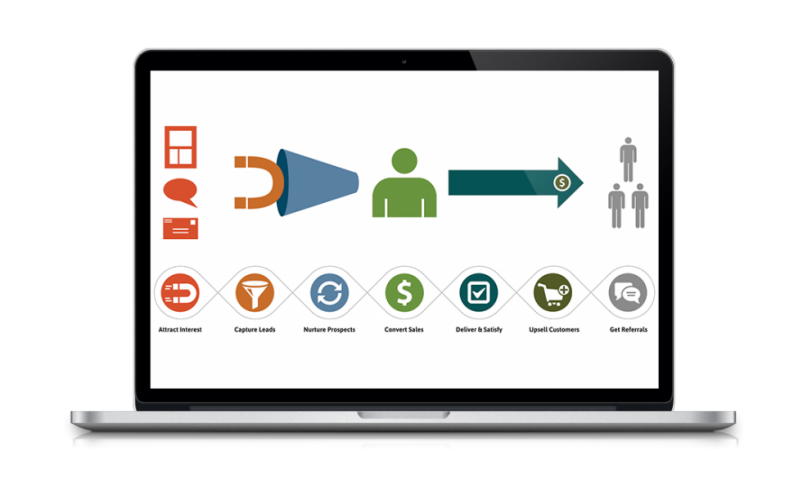Leave a Comment:
1 comment
[…] and you try to publish a few blog posts thinking it will help you acquire new customers, your “inbound marketing strategy” (or lack there of) will […]
Reply The inbound marketing methodology consists of 4 key stages.
The inbound marketing methodology consists of 4 key stages.
HubSpot has outlined this methodology to help businesses shift their mentality from the traditional, interruption campaigns to full inbound marketing. The inbound marketing methodology is built to put your brand on the path of your customers’ decision making process. By following this methodology, you can attract more customers, higher quality customers, and build your business on the happiness of your customers and the quality of your products.
This is how to deliver the perfect marketing efforts, by putting your message in the right place, at the right time, for the right person.
The Attracting stage of the inbound marketing methodology is where strangers to your business become visitors to your website (or other online platforms) and become acquainted with your brand.
The world has changed. You can no longer have your brand screaming at customers while they are in the middle of something completely unrelated to how you can do business together.
TV commercials for instance, magazine ads, radio spots, direct mail, they all interrupt what the audience is doing at that time to try and grab their attention and sell to them.
 The inbound marketing methodology puts your brand in front of customers when they are actually looking for what you have to offer.
The inbound marketing methodology puts your brand in front of customers when they are actually looking for what you have to offer.
When you build your inbound marketing engine and are publishing content that shows up in Google for words that your customers are looking for (blogging, keywords) and you’re joining in on conversations with helpful tips and information (social media), you are coming into the picture as your customer needs that information. It makes sense to appear to them when they are searching Google for issues that you can help with. That’s when they want to hear from you! Not when they’re sitting on the couch relaxing with their family at night trying to enjoy their favorite TV show.
By following the inbound marketing methodology and implementing it with full force, you will dominate your market by putting your brand on the path of your customers’ decision making process and actually ATTRACT MORE CUSTOMERS.
While there are many ways to attract visitors to your website, the Hubspot Inbound Marketing Methodology highlights 3 key components
Blogging has moved beyond being a way to gain an advantage over your competition and is now a necessary part of any inbound marketing gameplan.
Because Google rewards websites that are authoritative in their industry, proving your credibility is important, not just to your customers, but to the almighty Google search engine algorithm.
A common misconception is that search engines rank websites as a whole for keywords. The truth is that Google’s algorithm wants one page that is dedicated to the keyword or phrase that the searcher has typed in. That means you need a dedicated page on your website for every keyword that you want to rank for.
What’s the best way to publish high quality pages to your website on a regular basis to not only build your audience, but establish your authority? That’s right, by blogging.
The more blog posts you have, the more keywords you can target and the more people will be finding you when they are searching Google for your products and services.
Before you start blogging however, you need to have an idea of what keywords you want to target. There’s a balance of choosing keywords so that you are targeting keywords that people are actually searching for (you don’t want to put effort into ranking for a word that has no potential for driving visitors to your website) and that the competition level for your target keywords is not too difficult for you to overcome.
The first step in choosing your keywords is to make a list of:
You can get into even more detail by creating buyer personas for your different ideal customers and their buying stages. With this outline, you can map who you want to target and exactly what their mentality is at the time so you can better resonate your messaging with their needs and move them along their buying process.
Once you have that list, you’ll want to use a tool to check how many people are searching every month for those words and how much competition those keywords have.
The most common (and free) tool is the Google Keyword Planner, which can tell you the traffic potential and a vague competition level (that’s a conversation for another blog post).
Social media can play several roles in your inbound marketing efforts.
You can use social media for monitoring conversations and joining in where you see opportunities.
You can promote your own content as a broadcast message.
You can build relationships one-on-one with influencers in your industry and with your customers.
Social media can help humanize your brand and create a connection with your audience that will resonate into more than just customer acquisition, but turn your customers into amplifiers of your brand. Which will then attract more ideal customers to your business, because who do you think your ideal customers that are amplifying your brand’s content are hanging around with? That’s right, each other.
There are more strategies and tactics within the inbound marketing methodology than can be listed here. What methods of inbound marketing have you used to attract visitors to your online platforms?
Leave your thoughts and questions in the comments below!
Is the inbound marketing methodology right for your business?

[…] and you try to publish a few blog posts thinking it will help you acquire new customers, your “inbound marketing strategy” (or lack there of) will […]
Reply